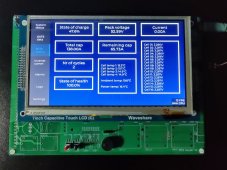Mariner62
New Member
- Joined
- Dec 29, 2020
- Messages
- 84
Hi Seplos Gurus,
I have two Seplos Mason 280 systems where the V16 BMS are interconnected with RS-485 and also connected to a Victron CerboGX via CANbus. Pack0 is connected to the CerboGX via CAN, Pack1 is connected to Pack0 via RS485.
I have noticed some interesting behaviour, which I would like to better understand if this is just a limitation, or whether its something I can fix.
When I set the DIPs as follows, then I get the behaviour below:
Pack 0: ALL OFF, Pack 1: DIP1 ON, rest are OFF.
1. The CerboGX detects a Pack0 only.
2. When I connect my PC via RS485 (running the Seplos host software) to Pack0, I can access both Pack0 and Pack1 from the software and everything works fine.
This is ok except, the CerboGX only thinks I have one pack with 280Ah capacity. I need it to recognise both packs.
So, following the SEPLOS manual, I set the DIPS as follows, to get the CerboGX to recognise both packs:
Pack 0: DIP5 is ON, rest are OFF, Pack 1: DIP1 ON, rest are OFF.
3. The CerboGX now detects both packs and correctly reports 560Ah capacity.
4. When I connect my PC via RS485 (running the Seplos host software) to either Pack then the 485 comms don't work and I cannot access anything.
Interestingly, if I switch the Pack0 DIP5 from OFF to ON while PC is connected and accessing the system (from either pack) then the comms continue, but I cant switch packs, and if I break the coms and re-connect then it doesn't work any more.
I would like to get a configuration working which allows me to access both packs from the PC and also have the CerboGx recognise both packs (ie Pack0 DIP5 needs to be ON).
Unfortunately I have not found a way to do this ... any clues anyone??
Cheers all
I have two Seplos Mason 280 systems where the V16 BMS are interconnected with RS-485 and also connected to a Victron CerboGX via CANbus. Pack0 is connected to the CerboGX via CAN, Pack1 is connected to Pack0 via RS485.
I have noticed some interesting behaviour, which I would like to better understand if this is just a limitation, or whether its something I can fix.
When I set the DIPs as follows, then I get the behaviour below:
Pack 0: ALL OFF, Pack 1: DIP1 ON, rest are OFF.
1. The CerboGX detects a Pack0 only.
2. When I connect my PC via RS485 (running the Seplos host software) to Pack0, I can access both Pack0 and Pack1 from the software and everything works fine.
This is ok except, the CerboGX only thinks I have one pack with 280Ah capacity. I need it to recognise both packs.
So, following the SEPLOS manual, I set the DIPS as follows, to get the CerboGX to recognise both packs:
Pack 0: DIP5 is ON, rest are OFF, Pack 1: DIP1 ON, rest are OFF.
3. The CerboGX now detects both packs and correctly reports 560Ah capacity.
4. When I connect my PC via RS485 (running the Seplos host software) to either Pack then the 485 comms don't work and I cannot access anything.
Interestingly, if I switch the Pack0 DIP5 from OFF to ON while PC is connected and accessing the system (from either pack) then the comms continue, but I cant switch packs, and if I break the coms and re-connect then it doesn't work any more.
I would like to get a configuration working which allows me to access both packs from the PC and also have the CerboGx recognise both packs (ie Pack0 DIP5 needs to be ON).
Unfortunately I have not found a way to do this ... any clues anyone??
Cheers all



